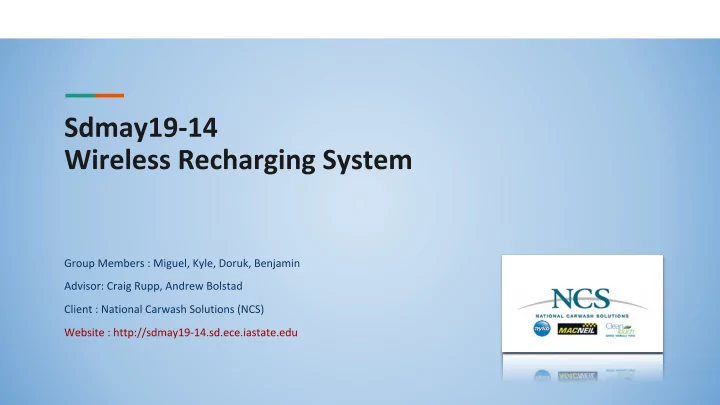

Problem Statement National Carwash Solutions has a sensor on a car wash arm that is powered by a set of batteries . Currently, the batteries are not rechargeable and they have proposed to employ a wireless charging system. The sensor cannot be powered using a wired connection due to the car wash arm being able to rotate completely around a base point. To avoid entangling electrical power cables, a wireless charging system is the most viable option to provide constant power for the sensor.
Concept Diagram
System Design Integration System’s Integration Diagram System’s Development Diagram
Functional / Non - Functional Requirements Functional requirements - Transmit power wirelessly through the air - Provide a stable 3v/100mA supply for sensor load - Provide a stable 12v/1A supply for an LED strip - Seperate Battery Charging systems for both LED and sensor loads - Monitor the system(s) with an onboard microcontroller Non-functional requirements - Environmentally protecting device(s) against water and heat - Alerting the user in case of critical battery or system state - Having a long battery back lifespan - Allowing options in the future for expansion and development
Transmitter Design
Transmitter Design
Receiver Design
Receiver Design
Microcontroller Monitors the power systems of the receiver battery packs so that: - Outputs given to operator about state of power systems - Control of LEDs to both functional and entertainment purposes - Be easily programmable and updateable to accommodate changes in the future Example Code
Transmitter Test Results Power vs Distance Rectified Delivered Power
Receiver Test Results Sensor Battery Pack Charging Power levels are what we would expect to see when charging the sensor battery Top : Battery charging voltage Bot: Battery charging current
Programming and Testing (attiny44) Using an arduino and the arduino programming software, code can be uploaded to the attiny with the arduino acting as a programmer for the onboard controller Using an arduino makes code creation, uploading, and testing, easier and simpler
Use-Case Scenarios and Applicability - Coding options leave room to change use of project - Wireless charging of higher power devices such as Quadcopters, Hoverboards, or RC cars possible - Making longer range transmitter based off design
System Containment - Use of epoxy layer - Minimal entry points - Inclined lid for liquid direction - Designed for specific use
Battery Choice - Safety Standards - Voltage/Current rates Samsung 30q - Mono vs Duo Pack decision effects Great Power Battery Co. Ltd. Shenzhen PKCELL Co. Ltd. Samsung 25r
Constraints/Trade-offs Functionality vs Efficiency Some aspects of the project, such as power loss, were not made a main focus, as overall functionality was needed most to prove viability and do-ability of project. Versatility vs Optimization We aimed to design our project in a way that modifications could be more easily made, while allowing potential for more versatile device(s). Future work can expand upon and get refined as needed, instead of being limited to a unique path of development.
Project Planning and timelines
Project Status Evaluation What is our project’s state (what works what doesn’t) ? - The project functions and can transmit and receive power wirelessly, and charge sensor battery - On board microcontroller can sense battery voltages and alert user about the state of the system - Room for improvement and expansion of the design - Client satisfied with our work and progress
Future Works ? - Making design more optimized and efficient - Adding extra features to the system (extra coding options, extra sensors….) - Adding an additional isolating layer for the cables that goes into the boxes at the entry points - Improving versatility and useability of components
Thank You Questions……?
Recommend
More recommend